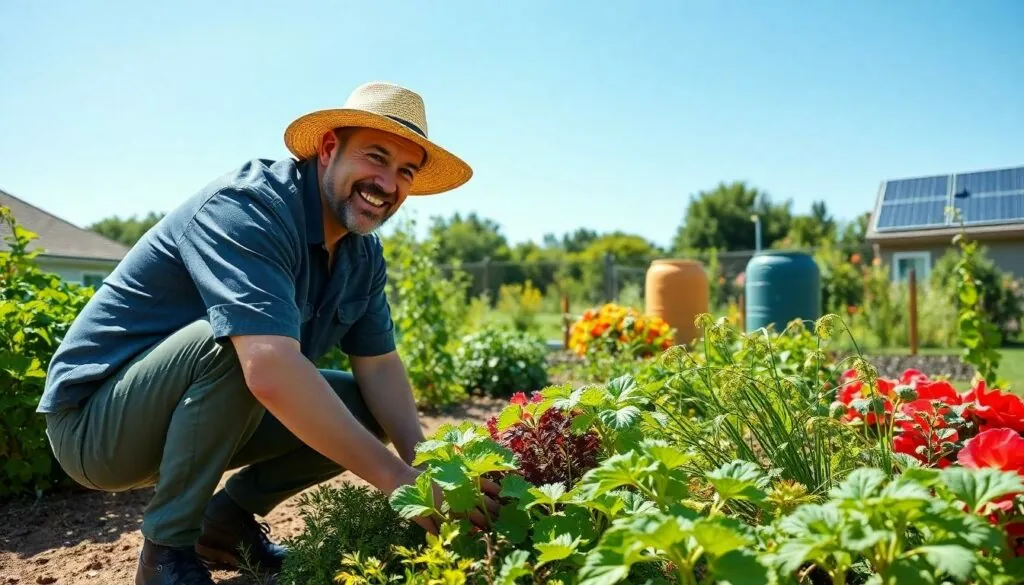Table of Contents
ToggleImagine waking up to the sound of chirping birds, the sun shining on your backyard garden, and knowing you’re living your best life—self-sustainable style. Self-sustainable living isn’t just a trend; it’s a lifestyle choice that empowers individuals to reduce their carbon footprint while enjoying the sweet fruits (literally) of their labor.
With a bit of creativity and elbow grease, anyone can transform their home into a mini-ecosystem that thrives on renewable resources. Who wouldn’t want to grow their own veggies while saving a few bucks at the grocery store? Plus, think of all the bragging rights at the next neighborhood barbecue! Dive into the world of self-sustainability and discover how easy it is to live green, save green, and maybe even impress your friends with your newfound gardening skills.
Overview of Self Sustainable Living
Self-sustainable living embodies a lifestyle that empowers individuals to cultivate their own resources while minimizing environmental impact. This approach emphasizes growing food, harvesting rainwater, and using renewable energy sources. Doing so creates a harmonious balance between personal needs and ecological responsibility.
Many individuals find it feasible to design their homes as mini-ecosystems. They can utilize vertical gardens, hydroponics, and composting systems. Such methods not only yield fresh produce but also optimize space. Many benefits arise from this lifestyle, including cost savings on groceries and enhanced food security.
Incorporating renewable energy systems remains crucial. Solar panels or wind turbines provide clean, sustainable energy for daily needs. Implementing these systems often reduces reliance on traditional power grids.
Communities also play a significant role in self-sustainability. Connecting with local groups fosters resource sharing and knowledge exchange. Collaborative efforts can lead to larger community gardens or cooperative buying programs.
Saving water becomes essential as well. Rainwater harvesting systems help capture and reuse water, easing the strain on local supplies. Utilizing greywater systems further enhances water efficiency.
Embracing self-sustainable living cultivates not only personal fulfillment but also a greater sense of community. It encourages individuals to appreciate the environment and take actionable steps towards a sustainable future. By prioritizing self-sufficiency, many contribute positively to their surroundings and inspire others.
Benefits of Self Sustainable Living

Self-sustainable living offers numerous advantages for individuals and communities alike. Embracing this lifestyle promotes better environmental health and economic benefits.
Environmental Impact
Sustainable living significantly reduces overall carbon footprints. It fosters biodiversity by creating habitats for various plants and animals. Each home can transform into a mini-ecosystem, enhancing local ecosystems. Utilization of renewable energy sources plays a crucial role, minimizing reliance on fossil fuels. Conserving water through rainwater harvesting and greywater systems lessens strains on municipal supplies. Planting diverse gardens encourages reduced pesticide use, improving air and soil quality. Communities benefit as cleaner environments promote healthier living conditions for everyone.
Economic Advantages
Self-sufficient households save substantial money on groceries. Growing food locally decreases expenses related to transportation and packaging. Lower energy bills result from using renewable energy sources like solar panels. Investing in composting systems reduces waste disposal costs significantly. Many individuals discover that DIY home improvements lead to better long-term financial stability. Gardening, in turn, can create a secondary income through selling excess produce. By participating in community gardens, individuals can share resources and lower overall costs.
Key Principles of Self Sustainable Living
Self-sustainable living revolves around fundamental practices aimed at minimizing environmental impact while optimizing resource use. Key principles focus on reducing waste, harnessing natural energy, and fostering community connections.
Reduce, Reuse, Recycle
Reducing consumption curtails waste generation. Reusing items, like repurposing glass jars for storage, extends the life of products. Recycling materials keeps them out of landfills and conserves valuable resources. Communities often organize recycling programs, enhancing participation and efficiency. By consciously opting for products with sustainable packaging, individuals contribute to less waste entering the environment. Engaging in local swap events promotes resource sharing and fosters community bonds. Creating compost from organic waste significantly reduces trash while enriching soil for gardens. These practices contribute to a circular economy, benefiting both individuals and the planet.
Renewable Energy Sources
Renewable energy sources offer sustainable alternatives to fossil fuels. Solar panels harness sunlight to generate electricity, significantly lowering utility bills. Wind turbines convert wind energy into power, efficiently supplying households with clean energy. Not only do these methods reduce carbon footprints, but they also enhance energy independence. Installing geothermal heating systems provides stable temperatures year-round, utilizing natural earth heat. Communities often invest in shared energy projects to diversify energy sources and reduce costs. Public incentives and grants can facilitate access to renewable energy technologies. Embracing such innovations leads to a sustainable future while promoting environmental stewardship.
Practical Steps to Achieve Self Sustainable Living
Self-sustainable living requires intentional actions, setting achievable goals, and implementing practical strategies. Individuals can begin by focusing on home gardening and water conservation techniques.
Home Gardening
Growing food at home offers many advantages. It provides fresh produce and reduces reliance on store-bought items. Start by selecting a space for planting, such as a backyard or balcony. Consider using containers for smaller areas. Diverse crops, including vegetables, herbs, and fruits, enhance nutrition and aesthetics. Using organic practices minimizes chemical exposure. Implementing vertical gardens optimizes space, allowing for creative arrangements. Regularly composting kitchen scraps fosters soil health and boosts plant growth. Resources such as local gardening clubs can offer advice and support in developing effective techniques.
Water Conservation Techniques
Water conservation plays a crucial role in self-sustainable living. Methods such as rainwater harvesting allow the collection of natural precipitation for irrigation and other uses. Installing a rain barrel beneath downspouts captures runoff efficiently. Greywater systems also promote sustainability by diverting water from sinks and showers for landscape irrigation. Simple changes like fixing leaks reduce waste significantly. Opting for drought-resistant plants minimizes irrigation needs while maintaining a vibrant landscape. Incorporating mulch in garden beds helps retain moisture, reducing watering frequency. By implementing these strategies, individuals can effectively manage water resources and contribute to sustainability goals.
Challenges of Self Sustainable Living
Self-sustainable living presents various challenges that individuals must navigate. Limited space in urban areas often hinders the ability to cultivate gardens effectively. Planning and designing a self-sustaining ecosystem requires thoughtful consideration of available resources. Weather conditions can also impact crop yields, making consistent food production difficult.
Financial investment might deter some individuals from initiating self-sustainable projects. Installing solar panels or rainwater harvesting systems incurs upfront costs that may seem daunting initially. Knowledge gaps exist; not everyone possesses expertise in sustainable practices, which hampers implementation.
Time constraints pose another significant challenge. Maintaining a garden, managing compost, and utilizing renewable energy demands consistent effort and attention. Balancing these responsibilities with work and family commitments can prove overwhelming.
Community support remains crucial for overcoming these difficulties. Lack of access to local networks or resource-sharing groups can limit opportunities for collaboration and learning. Some individuals might feel isolated in their self-sustainable journey, as finding others with similar goals may be challenging.
Regulatory and zoning issues can complicate efforts to implement certain sustainable practices. Local laws regarding rainwater collection or composting may restrict individuals’ ability to fully embrace self-sufficiency. Awareness of these regulations often becomes necessary to avoid potential penalties.
Realizing the benefits of self-sustainable living requires resilience and determination. By facing these challenges head-on, individuals can foster stronger connections to their environment and communities. Overcoming obstacles not only enhances capability but also elevates the overall experience of self-sustainable living.
Self-sustainable living offers a pathway to a greener lifestyle filled with personal satisfaction and community engagement. By embracing practices like gardening, water conservation, and renewable energy, individuals can significantly reduce their environmental impact. The journey towards self-sufficiency not only enhances one’s quality of life but also fosters a deeper connection with nature and the local community.
Overcoming challenges may require effort and resourcefulness, but the rewards are well worth it. As more individuals adopt self-sustainable practices, they contribute to a collective movement that inspires others to follow suit. Ultimately, this lifestyle choice not only benefits individuals and families but also promotes a healthier planet for future generations.




